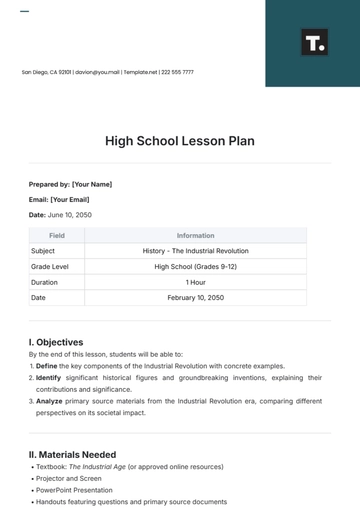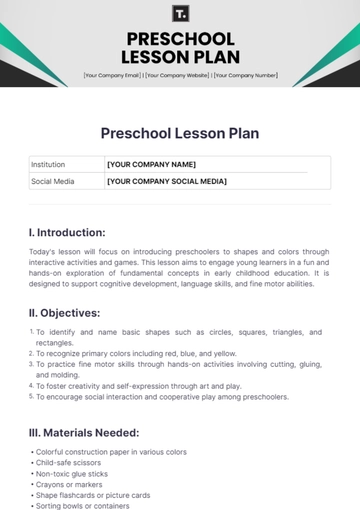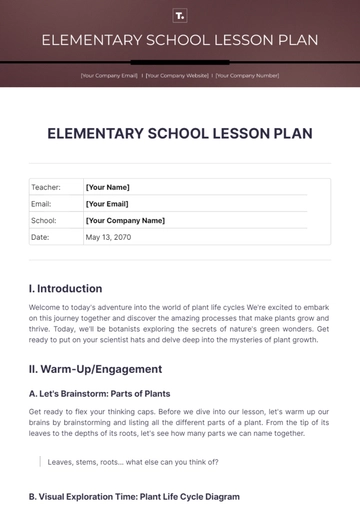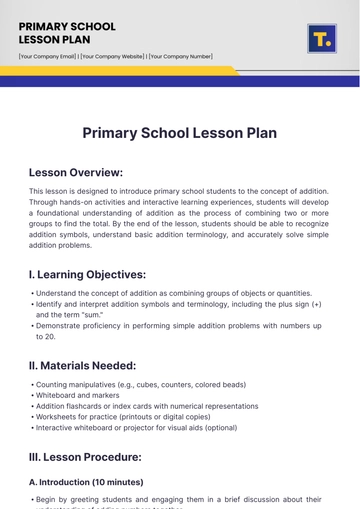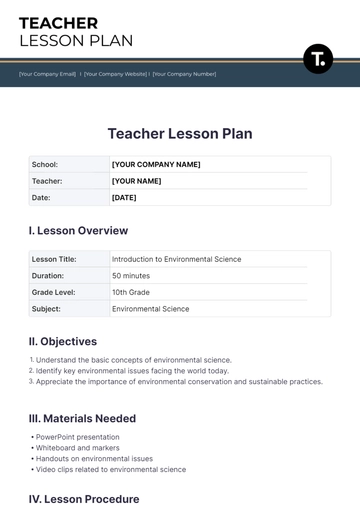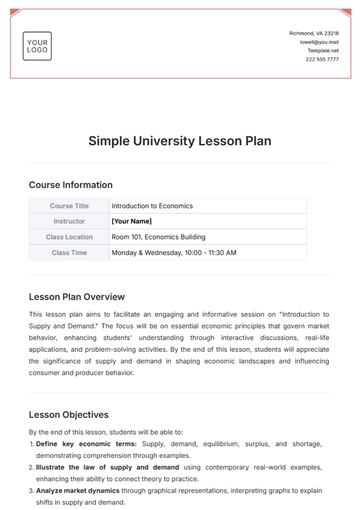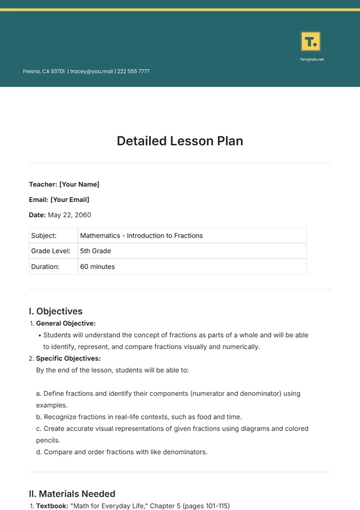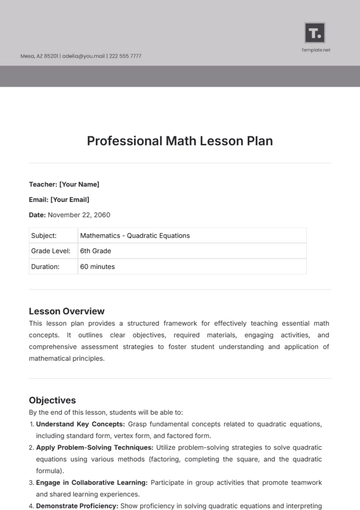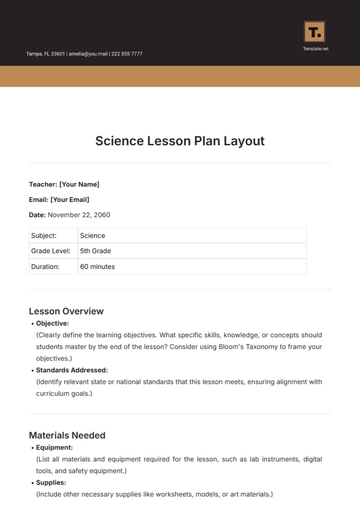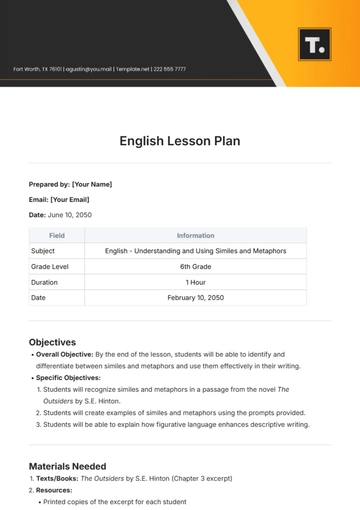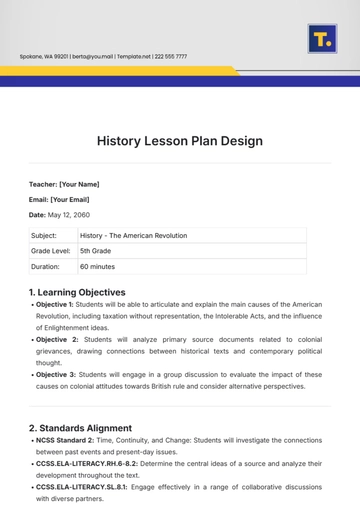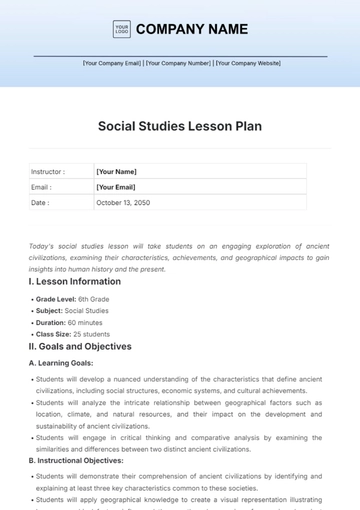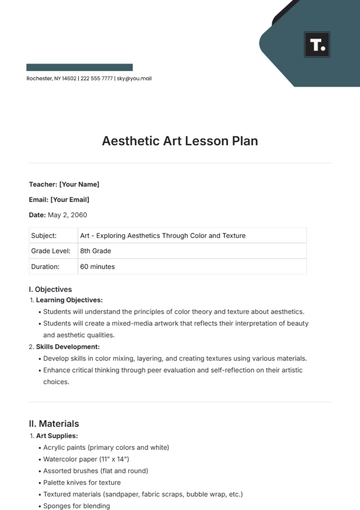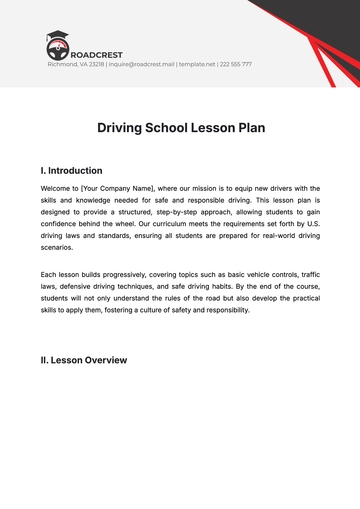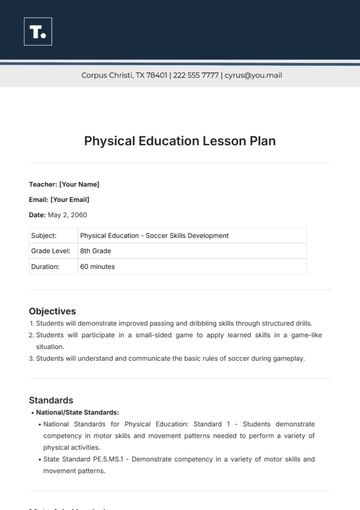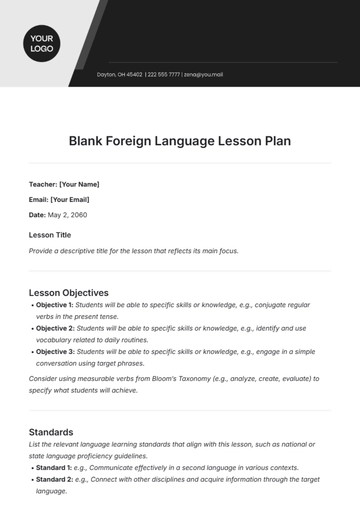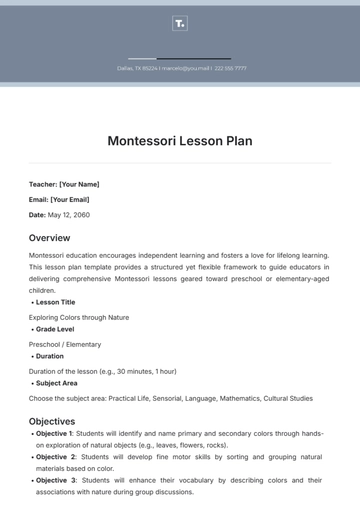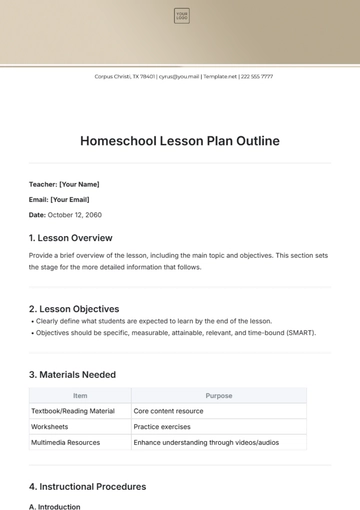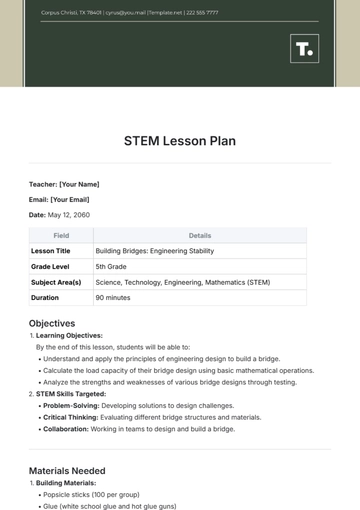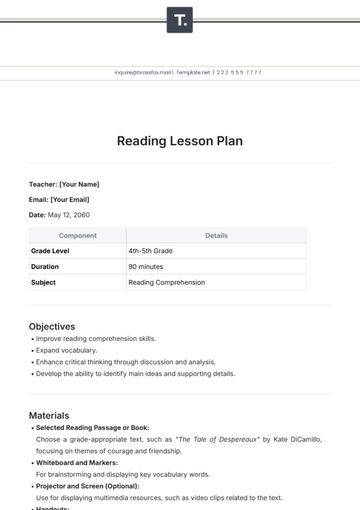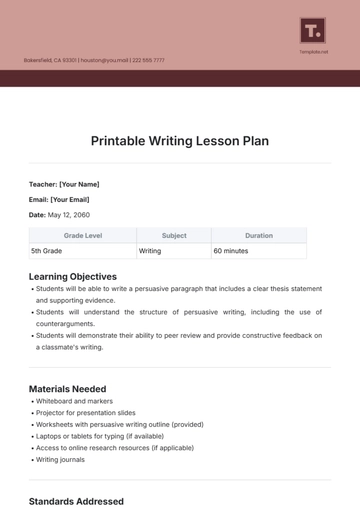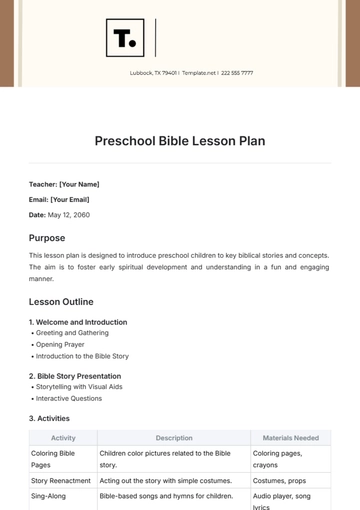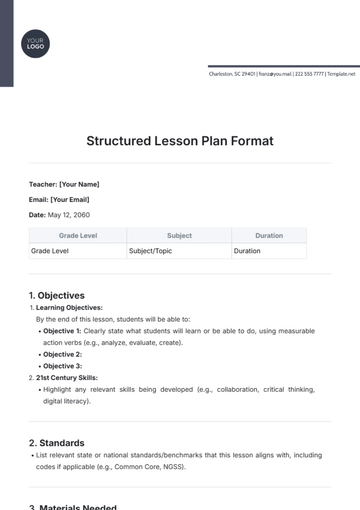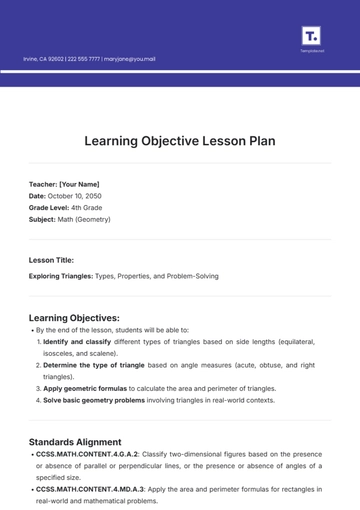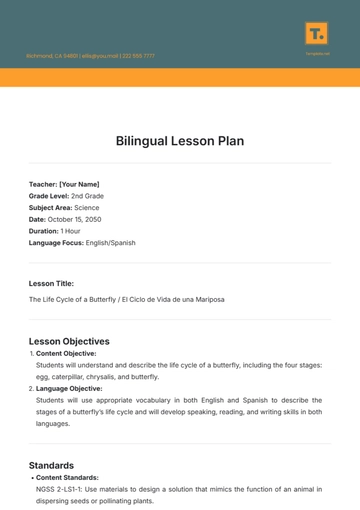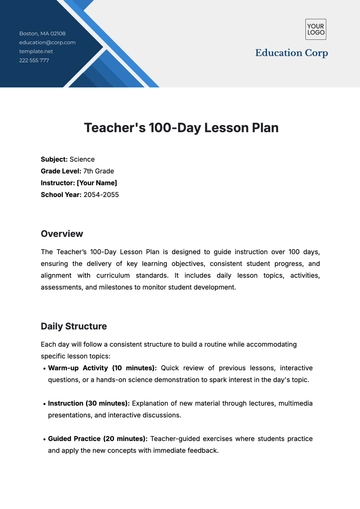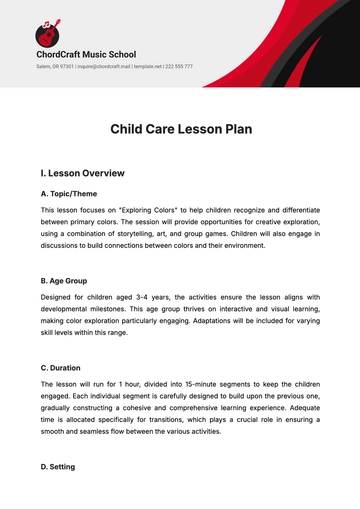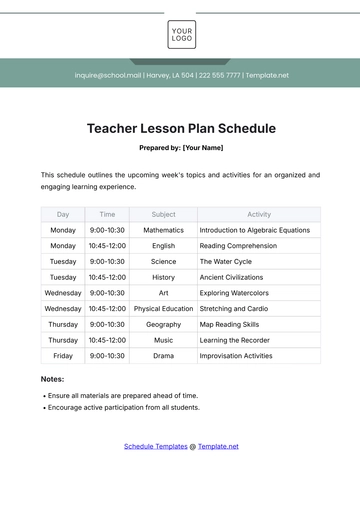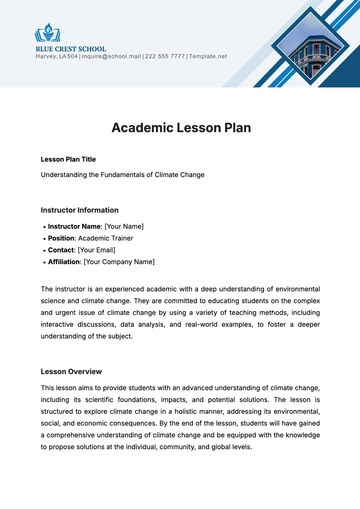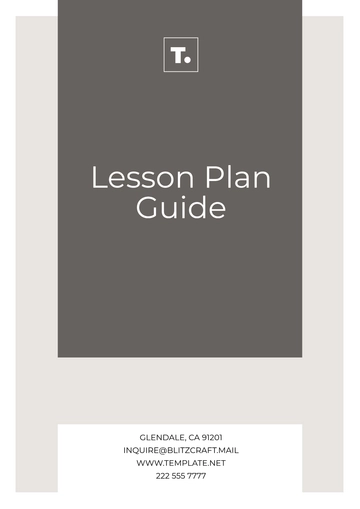Free Kindergarten Daily Lesson Plan

I. Overview
Date: January 3, 2050
Time: 8:00 AM - 2:30 PM
Age Group: Kindergarten
Teacher: [Your Name]
Objective: Introduce basic concepts of numbers, letters, and social interaction, fostering a love for learning and encouraging developmental milestones.
II. Schedule
Time | Activity | Description |
|---|---|---|
8:00 - 8:30 | Arrival and Free Play | Children arrive and engage in unstructured play to settle in. |
8:30 - 9:00 | Morning Circle Time | Group greeting, discuss the weather, day of the week, and schedule for the day. |
9:00 - 9:30 | Alphabet Lesson | Introduction to letters A, B, and C using interactive cards and songs. |
9:30 - 10:00 | Snack Time | Healthy snacks provided; time for social interaction. |
10:00 - 10:30 | Math Lesson | Counting from 1 to 10 with number blocks and group activities. |
10:30 - 11:00 | Outdoor Play | Physical activities and games in the playground to develop motor skills. |
11:00 - 11:30 | Story Time | Reading "The Very Hungry Caterpillar" followed by a discussion. |
11:30 - 12:00 | Music and Movement | Singing children's songs, simple dance steps, and rhythm exercises. |
12:00 - 12:30 | Lunch | Nutritional lunch, followed by quiet conversation. |
12:30 - 1:00 | Rest Time | Relaxation and quiet time; children can nap or read quietly. |
1:00 - 1:30 | Art and Craft | Creating ABC-themed art using crayons, paper, and glue. |
1:30 - 2:00 | Free Play | Unstructured playtime allowing children to explore activities of their choice. |
2:00 - 2:30 | Closing Circle Time | Recap of the day’s activities, sharing experiences, and preparing for dismissal. |
III. Materials Needed
Material | Description |
|---|---|
Alphabet Cards | Large, colorful cards for visual learning of letters. |
Number Blocks | Blocks with numbers for counting exercises and math games. |
Snacks | Healthy snacks such as fruits, crackers, and water. |
Books for Story Time | "The Very Hungry Caterpillar" by Eric Carle. |
Music Playlist | Selection of children’s songs for singing and dancing. |
IV. Details
1. Morning Circle Time
Activity: Morning greetings to foster social interaction. Discuss the weather, calendar updates, and an overview of the day’s schedule.
Objective: Encourage children to participate and feel part of the group.
2. Alphabet Lesson
Activity: Focus on letters A, B, and C through interactive alphabet cards and songs.
Objective: Help children recognize and pronounce the letters, laying the foundation for literacy.
3. Math Lesson
Activity: Use number blocks to count from 1 to 10, incorporating games and group counting.
Objective: Develop basic numeracy skills and understand the concept of numbers.
4. Story Time
Activity: Read "The Very Hungry Caterpillar" and engage children in a discussion about the story.
Objective: Enhance listening skills, comprehension, and vocabulary development.
5. Music and Movement
Activity: Sing popular children’s songs and learn simple dance moves to improve coordination.
Objective: Promote physical activity, rhythm, and musical appreciation.
V. Assessment
Assessing young children in a kindergarten setting involves a combination of observation, direct interaction, and review of their work. The goal is to ensure they are progressing in their understanding of basic concepts, developing social skills, and enjoying their learning experiences.
1. Observation
During Activities: Pay close attention to how children interact during each scheduled activity. Look for signs of engagement, such as attentiveness during story time, enthusiasm during music and movement, and concentration during art and craft.
Behavioral Indicators: Note behaviors that indicate understanding and participation, such as raising hands to answer questions, collaborating with peers during group tasks, and following instructions.
Social Interaction: Observe how children interact with one another during free play and structured activities. Look for examples of sharing, taking turns, and cooperating with others.
2. Participation
Group Activities: Track which children are actively participating in group activities, such as morning circle time, alphabet lessons, and math exercises. Participation can be verbal (answering questions, singing along) or non-verbal (following along, nodding in understanding).
Initiative and Leadership: Identify children who take the initiative or show leadership qualities, such as organizing their peers during free play or helping others during structured activities.
Engagement Levels: Assess the levels of enthusiasm and engagement. Children who are engaged are likely to be more vocal, ask questions, and show interest in the materials and activities.
3. Review of Completed Work
Math Exercises: Review counting activities and use of number blocks. Assess accuracy in counting and their ability to recognize and order numbers.
Alphabet Lessons: Check how well children can recognize and pronounce the letters A, B, and C after the lesson. Use alphabet cards and simple assessments to measure retention.
- 100% Customizable, free editor
- Access 1 Million+ Templates, photo’s & graphics
- Download or share as a template
- Click and replace photos, graphics, text, backgrounds
- Resize, crop, AI write & more
- Access advanced editor
Transform your kindergarten classroom with the Kindergarten Daily Lesson Plan Template offered by Template.net. This fully customizable and downloadable tool helps you organize your daily activities effortlessly. Easily editable in our AI Editor Tool, this template ensures every lesson is engaging and structured. Make planning a breeze with our printable format, perfect for maintaining consistency and fostering a dynamic learning environment.
